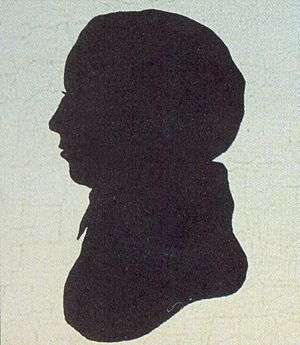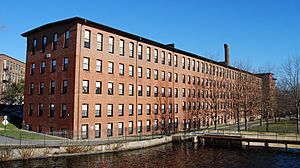Francis Cabot Lowell facts for kids
Quick facts for kids
Francis Cabot Lowell
|
|
|---|---|

Profile of Francis Cabot Lowell. There are no surviving portraits of him, so this cut-paper silhouette is commonly used.
|
|
| Born | April 17, 1775 |
| Died | August 10, 1817 (aged 42) |
| Resting place | Forest Hills Cemetery Jamaica Plain, Boston, Massachusetts |
| Education | Phillips Academy Roxbury Latin School |
| Alma mater | Harvard University |
| Occupation | Businessman |
| Children | John Lowell Jr. Francis Cabot Lowell Jr. Edward Lowell Susanna Lowell |
| Parent(s) | John Lowell Susanna Cabot |
Francis Cabot Lowell (born April 7, 1775 – died August 10, 1817) was an American businessman. The city of Lowell, Massachusetts, is named after him. He played a very important role in bringing the Industrial Revolution to the United States.
Contents
Early Life and Education
Francis Cabot Lowell was born in Newburyport, Massachusetts. His father, John Lowell, was a judge and a member of the Continental Congress. His mother was Susanna Cabot. Francis was very good at mathematics when he was young.
He graduated from Phillips Academy in 1786. Later, in 1793, he finished his studies at Harvard College.
A New Idea for America
After college, in 1795, Lowell traveled on a merchant ship. He visited places like Spain and France. He wanted to learn about trade and business. While in France, he saw the country going through a big revolution. In 1796, he came back to Boston and started his own trading business.
For many years, Lowell traded goods from other countries. He imported silks and teas from China. He also brought in cotton fabrics from India. He used his inheritance to invest in merchant ships. He also helped develop Boston Harbor for trade.
Even though the United States was independent, it still relied on other countries for manufactured goods. Conflicts in Europe and a law called the Embargo Act of 1807 made it hard to trade. Lowell realized that for America to be truly independent, it needed to make its own goods.
In 1810, Lowell visited Britain with his family. He was interested in their textile factories. He studied their spinning and weaving machines, which used water or steam power. He couldn't buy plans for these machines. So, he secretly memorized how the British power looms worked. He didn't write anything down. In Edinburgh, he met Nathan Appleton, who later became his business partner. When the War of 1812 started, Lowell returned home. His boat was searched, but he had no forbidden items.
Starting the Textile Industry
In 1814, Francis Cabot Lowell started a new company. It was called the Boston Manufacturing Company (BMC). He got help from his family and friends like Nathan Appleton. They built their first mill in Waltham, Massachusetts. This mill used the power of the Charles River.
The BMC mill was special. It was the first "integrated" textile mill in America. This meant that all the steps to turn raw cotton into finished cloth happened in one building. Lowell hired a skilled inventor named Paul Moody. Together, they designed better cotton spinning and weaving machines. These machines were based on the British ones, but they had many improvements. Lowell and Moody received a patent for their power loom in 1815.
To get money for their mills, Lowell and his partners sold shares of stock. This was a new way to raise money for businesses. Wealthy investors could buy shares and become part-owners of the company. This idea of selling shares is still used today by many companies.
The Lowell Mill Girls
The Waltham mill was a big success. It was a model for other factories in America. Lowell also started something new by hiring women to work in his factories. These women were usually between 15 and 35 years old. They came from farming families in New England. They became known as the Lowell mill girls.
The company provided boarding houses for the women. These houses had chaperones to look after them. The women also had chances to join religious and educational activities. The Waltham mill also made power looms to sell to other American cotton mills.
The success of the Waltham mill made Lowell's partners look for new places to build more factories. They found a good spot in East Chelmsford. After Lowell died, this new mill town was renamed "Lowell" in his honor.
Protecting American Business
After the War of 1812, British companies started selling cheap cotton cloth in America. This was a threat to the new American textile industry. In 1816, Lowell went to Washington, D.C. He successfully argued for a special tax on imported cotton goods. This tax, called the Tariff of 1816, helped protect American businesses.
Francis Cabot Lowell died on August 10, 1817. He was only 42 years old. He died from pneumonia. He had only been building his first mill for three years. But he left the Boston Manufacturing Company in good financial shape.
After his death, Lowell's partners expanded the business. They moved to the more powerful Merrimack River. They named their new mill town "Lowell" to honor him. The "Waltham-Lowell system," which Lowell started, spread across America. This system of mechanized textile production was very important for a century. It helped the United States become a leader in manufacturing.
Family Life
In 1798, Francis Cabot Lowell married Hannah Jackson. They had four children:
- John Lowell Jr., who later supported the Lowell Institute.
- Francis Cabot Lowell Jr., a businessman.
- Edward Lowell, a lawyer.
- Susanna Lowell.
Lowell was first buried in Boston. Later, in 1894, his body was moved to Forest Hills Cemetery.
Francis Cabot Lowell was recognized for his achievements after his death. He was inducted into the Junior Achievement U.S. Business Hall of Fame.
See also
| Wikisource has the text of a 1920 Encyclopedia Americana article about Francis Cabot Lowell. |
- Lowell family


